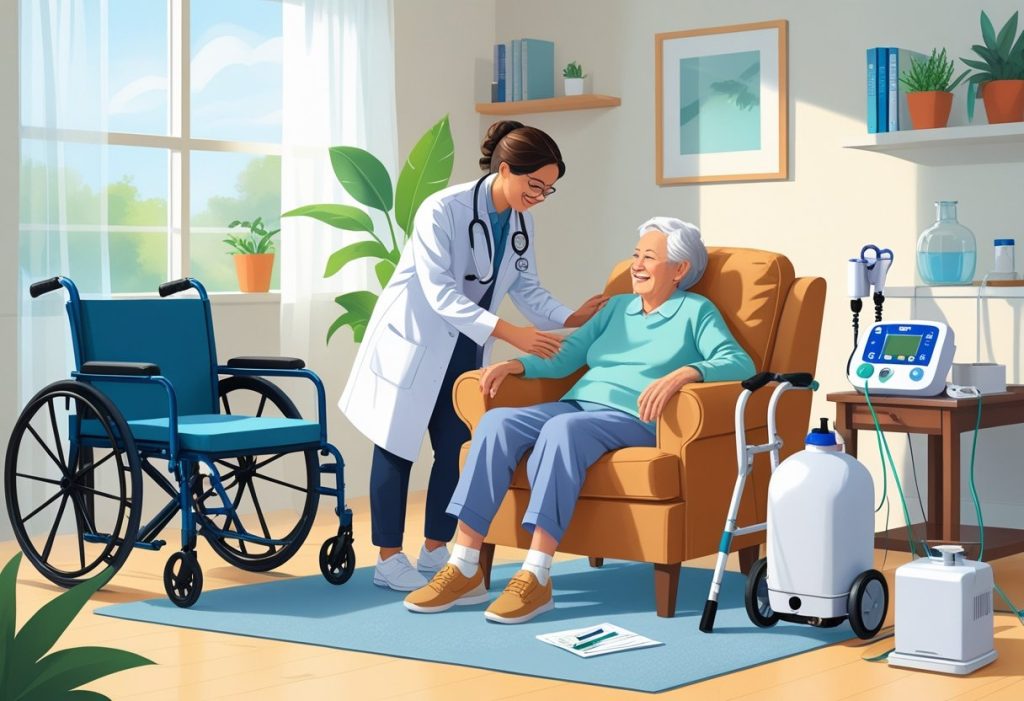Navigating the world of Medicare can be overwhelming, especially when it comes to understanding coverage for home medical equipment. Medicare can cover certain types of home medical equipment, provided they are deemed medically necessary and prescribed by your healthcare provider. This coverage can significantly ease the financial burden of acquiring the equipment you need to maintain your independence and comfort at home.
At The Modern Medicare Agency, we recognize that each individual’s needs are unique. Our licensed agents are real people who can help you understand your options and identify the Medicare packages that align with your specific requirements. With our guidance, you can find the coverage you need without hidden fees that can strain your budget.
You deserve personalized support as you navigate your Medicare options. By choosing The Modern Medicare Agency, you ensure that you have a knowledgeable partner on your side, ready to assist you in making informed decisions about your healthcare coverage, including essential home medical equipment.
How Medicare Covers Home Medical Equipment
Medicare provides essential coverage for various types of home medical equipment, known as durable medical equipment (DME). Understanding the specifics of what is covered and the eligibility criteria ensures you can access necessary medical support at home.
Definition of Durable Medical Equipment (DME)
Durable medical equipment (DME) refers to medical devices designed for repeated use. According to Medicare, DME must be:
- Durable: Capable of lasting over time.
- Medically necessary: Used for a medical reason rather than general comfort.
- Appropriate for home use: Designed primarily for use in a home setting.
Examples of DME include wheelchairs, oxygen equipment, and hospital beds. To be eligible for coverage, the equipment must fulfill these criteria and be prescribed by a healthcare provider.
Eligibility Criteria for Coverage
To qualify for Medicare coverage, certain criteria must be met. Specifically:
- Medically Necessary: The equipment must be deemed essential for your medical condition, as certified by a Medicare-enrolled doctor.
- Prescribed: A physician must issue a prescription for the DME. This serves as documentation for Medicare.
- Home use: Equipment is meant for use in your home, not in a hospital or clinical setting.
Additionally, Medicare requires that the DME be obtained from a supplier enrolled in Medicare. This ensures the equipment meets all necessary regulations and standards.
Roles of Medicare Part B and Medicare Advantage
Medicare Part B plays a significant role in providing coverage for DME. Under Part B, you may receive coverage for 80% of the DME costs after you meet your annual deductible. Remember that you must use a Medicare-approved supplier.
Medicare Advantage plans may also cover DME. These private plans often include additional benefits beyond what Part A and Part B offer. However, it’s crucial to review each plan’s details, as coverage and costs can vary.
For guidance tailored to your needs, consider The Modern Medicare Agency. Our licensed agents are here to consult with you directly and find Medicare packages that fit your specific requirements without hidden fees.
Requirements for Medicare Coverage of Medical Equipment
Understanding the requirements for Medicare coverage of medical equipment is crucial for anyone considering their options. This section outlines the necessary factors for eligibility, including medical necessity, supplier approval, usage context, and prior authorization.
Medical Necessity and Prescriptions
To qualify for Medicare coverage, the medical equipment must be deemed medically necessary. This determination is made by a Medicare-enrolled doctor who prescribes the equipment for your home use. The prescribed items must serve a specific medical purpose related to your diagnosis.
Medically necessary equipment falls under the Durable Medical Equipment (DME) category. Items typically include wheelchairs, oxygen supplies, and hospital beds. It’s important to ensure that your doctor documents the need for this equipment thoroughly.
Obtaining Equipment Through Medicare-Approved Suppliers
Once you have a prescription, you need to obtain the equipment through a Medicare-approved supplier. These suppliers meet specific guidelines set by Medicare and ensure that you receive the right products. Using a non-approved supplier may result in denied claims.
To find an approved supplier, you can visit the official Medicare website or contact your insurance representative. The Modern Medicare Agency can also assist you in identifying the right suppliers so you can navigate the process with ease.
Home Use Versus Facility Use
Medicare coverage is typically aimed at equipment for home use. Items must be necessary for daily living tasks and help maintain independence in your own environment. Equipment used in skilled nursing facilities or long-term care facilities may not be covered unless explicitly stated in your plan.
It’s essential to clarify with your healthcare provider and Medicare how these distinctions affect your coverage. Your Medicare plan may have specific criteria that define eligibility based on where the equipment is used.
The Prior Authorization Process
In some situations, obtaining coverage for medical equipment requires a prior authorization. This process involves your Medicare-enrolled doctor submitting necessary documentation and justifications for the equipment. The aim is to confirm that it aligns with Medicare guidelines.
Approval can streamline your access to equipment, avoiding potential delays. Not all equipment requires prior authorization, but understanding the guidelines is vital. Your provider can guide you on whether this step is needed for your specific case.
For assistance with navigating these requirements, working with The Modern Medicare Agency can be an ideal choice. Licensed agents offer personalized support and help you understand your options without hidden fees.
Types of Home Medical Equipment Covered by Medicare
Medicare provides coverage for a variety of home medical equipment essential for managing health conditions and enhancing daily living. Understanding what equipment is covered can help you make informed decisions about your care.
Mobility Aids: Walkers, Canes, and Crutches
Mobility aids are crucial for maintaining independence and safety at home. Medicare covers medically necessary mobility aids such as walkers, canes, and crutches when prescribed by a doctor.
Walkers provide support and stability as you move around your home. Canes can assist with balance and are lightweight for easier transport. Crutches are typically used for temporary conditions and achieve mobility while keeping weight off an injured leg.
To qualify for coverage, your healthcare provider must demonstrate the medical necessity of the equipment based on your specific health needs.
Wheelchairs: Manual and Power Options
Medicare covers both manual and power wheelchairs for individuals with mobility challenges. A doctor must prescribe these wheelchairs, and they must be deemed medically necessary.
Manual wheelchairs are operated by the user and offer flexibility for home and community use. They are lightweight and easy to maneuver. Power wheelchairs are battery-operated, ideal for those who cannot self-propel.
It’s essential to work with your healthcare provider to determine which option fits your lifestyle and mobility requirements best.
Respiratory Equipment: Oxygen and CPAP Machines
For individuals with respiratory conditions, Medicare provides coverage for oxygen equipment and CPAP machines. Coverage applies to medically necessary devices prescribed by a healthcare professional.
Oxygen equipment includes both stationary and portable units tailored to your needs. This equipment allows you to maintain adequate oxygen levels, supporting overall health and wellness. CPAP machines are crucial for those diagnosed with sleep apnea, ensuring you receive necessary airflow during sleep.
Ensure that your provider documents the medical necessity of these devices for smoother claims processing with Medicare.
Medical Monitoring and Infusion Devices
Medicare also covers various medical monitoring and infusion devices. This includes blood sugar monitors and infusion pumps necessary for chronic conditions like diabetes.
Blood sugar monitors assist you in managing diabetes effectively, allowing you to check glucose levels regularly. Test strips, essential for these monitors, are also covered when medically necessary.
Infusion pumps deliver medication directly into your bloodstream, ensuring accurate dosages for chronic conditions. These devices are vital for maintaining your health and managing symptoms. Follow your doctor’s recommendations to secure coverage for these essential tools.
For personalized assistance in navigating your Medicare options, consider partnering with The Modern Medicare Agency. Our licensed agents are available to discuss your unique needs and find plans that work for you without any hidden fees.
Costs, Deductibles, and Supplier Rules
Understanding costs, deductibles, and supplier rules is crucial when navigating Medicare coverage for home medical equipment. These factors directly influence your out-of-pocket expenses and the overall affordability of the equipment you need.
Part B Deductible and Coinsurance Explained
Medicare Part B has an annual deductible that you must meet before coverage begins. In 2025, this deductible is set at $233.50. Once you meet this deductible, you will typically pay 20% of the Medicare-approved amount for most durable medical equipment (DME).
It’s essential that the supplier providing your equipment is a Medicare-approved supplier. This designation ensures that the item qualifies for coverage under Part B. If your supplier is not approved, you may face higher costs or may not receive reimbursement at all.
Difference Between Renting and Buying Equipment
When acquiring home medical equipment through Medicare, you have the option to either rent or buy. Renting can often be a cost-effective solution, particularly for items you do not need long-term. For example, items like hospital beds or wheelchairs may be rented for a monthly fee.
If you choose to purchase equipment, you typically own it outright after the initial payment. This may be advantageous for items required for ongoing use. Consider that, with DME, Medicare generally covers the rental cost for items furnished for a limited time, while purchasing may involve different cost structures and requirements.
Potential Out-of-Pocket Expenses
While Medicare does cover a significant portion of DME costs, potential out-of-pocket expenses may still arise. Factors affecting your total costs include the specific item, your chosen supplier, and whether you have met your deductible.
It’s also important to consider any coinsurance due after the deductible is met. In some cases, there might be additional costs if the supplier’s charges exceed the Medicare-approved amount. To ensure clarity and budget effectively, always consult with a professional, like those at The Modern Medicare Agency. Our licensed agents can help you navigate these complexities without any hidden fees.
What Medicare Does Not Cover and Additional Assistance Options
Understanding the limitations of Medicare coverage is crucial for effectively managing your healthcare needs. While Medicare provides significant benefits, there are key exclusions and alternative assistance options available.
Commonly Excluded Equipment and Supplies
Medicare often does not cover certain types of durable medical equipment (DME). For instance, items like personal mobility devices (excluding devices like wheelchairs and walkers), home modifications (such as stairlifts), and non-medical supplies (like adult diapers) are not included in standard coverage.
Additionally, cosmetic equipment, including items for aesthetic purposes, also falls outside Medicare’s purview. You may need to explore other avenues for acquiring these essential items, particularly if they play a role in your daily living or safety.
Differences Between Medicare and Medicaid Coverage
While Medicare primarily covers individuals aged 65 and older, Medicaid serves low-income individuals regardless of age. This distinction impacts coverage for home health services and DME.
Medicaid may cover more extensive long-term care services, including personal care and assistance that Medicare doesn’t. For example, Medicaid can provide funding for in-home care that helps with daily activities for those who qualify, offering options that are more comprehensive than Medicare’s limitations.
Exploring Home Health and Long-Term Care Coverage
Medicare does cover some home health services, but only if they are medically necessary and ordered by a doctor. Coverage typically includes skilled nursing care, physical therapy, and other related services, but it does not extend to non-medical personal care.
Long-term care facilities, such as nursing homes, may not be covered under Medicare unless specific conditions are met. It’s essential to assess your situation to determine if you need additional support.
For personalized guidance on navigating Medicare and exploring available options, consider reaching out to The Modern Medicare Agency. Our licensed agents offer one-on-one assistance, helping you identify packages that meet your needs without additional financial burdens.
Frequently Asked Questions
Understanding Medicare’s coverage for home medical equipment can help you make informed decisions. Here are key considerations regarding what is covered, how to qualify, and specific equipment details related to your needs.
What types of durable medical equipment are covered by Medicare?
Medicare typically covers a range of durable medical equipment (DME) that is medically necessary. This includes items such as wheelchairs, hospital beds, oxygen equipment, and CPAP machines. Understanding which specific items are included can help you plan for your health care needs.
How does one qualify for home medical equipment coverage under Medicare?
To qualify for coverage, a physician must prescribe the equipment as necessary for your health condition. Additionally, the equipment must meet Medicare’s criteria for durability and medical necessity. You need to ensure that the equipment is for home use to receive coverage under Medicare Part B.
What duration of coverage does Medicare provide for CPAP supplies?
Medicare covers CPAP supplies, including masks and tubing, under specific guidelines. Typically, you can receive coverage for replacements every few months, depending on usage and necessity. Periodic assessments by your healthcare provider will determine ongoing eligibility.
Are there any specific types of medical equipment that Medicare does not cover?
Certain items fall outside Medicare coverage. These include equipment deemed not necessary for medical reasons or items primarily for convenience or comfort. Examples are air purifiers and exercise equipment, which do not qualify under DME.
Which Medicare plan includes coverage for home medical equipment?
Medicare Part B is the primary plan that covers durable medical equipment. This part of Medicare assists with costs associated with medically necessary equipment prescribed for home use. It’s essential to understand the guidelines specific to Part B to maximize your benefits.
Does Medicare offer a catalog or list of free medical supplies, and if so, how can it be obtained?
Medicare does not provide a catalog of free medical supplies. However, you can check with your Medicare provider or visit the official Medicare website to see what is covered and how to obtain necessary supplies. It’s important to connect with licensed agents at The Modern Medicare Agency for personalized assistance regarding options available to you.






